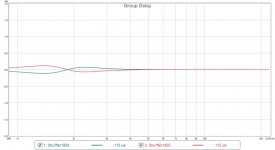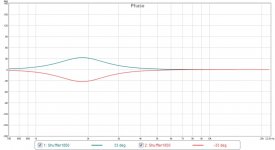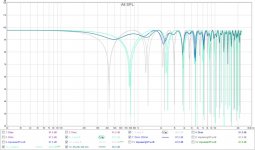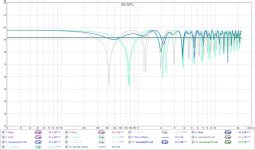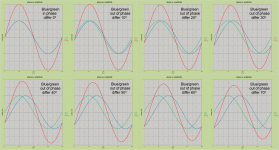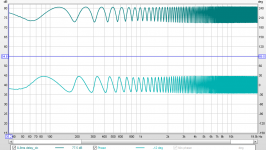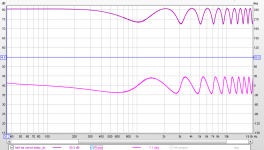I just tried the single shuffle at 1850. It does fix a lot. It might be enough to only keep that one. The time penalty is very small too. I probably will try fixing 5500 too though. I can't help it, it's in my nature to be curious. If I do, I'll use a smaller phase swing there.

Maximum time delay/advance for a single channel is 0.115 ms @ 1375 Hz.

Phase spread between left/right channels 66 degree @ 1850 Hz
Maximum time delay/advance for a single channel is 0.115 ms @ 1375 Hz.
Phase spread between left/right channels 66 degree @ 1850 Hz
Attachments
Further to my idea of Post # 356 i experimented on the song, Hang on to your love by Sade, with the following.
I converted the song into mono, & then imported it into a multitrack audio editor etc on Track 1. Then imported the original stereo song onto Tracks 3 & 4 as well. Then i moved the mono Track 64th of a bar behind the stereo one to delay it slightly. I also reduced the level of it by 6db & added a few db of hf EQ & lowered the lf EQ by a few db. When i say a few, that's because i tinkered with various settings & can't remember exactly what they were ! Anyway, i'm sure you'll find the sweetspot somewhere
The delay could be even shorter, along with altering the mono level & EQ's. Try it & see what you think. Interestingly, so far the stereo image doesn't appear to suffer
I don't think adding and delaying a copy of the Mid channel is a good approach, since it will create substantial (electronic) comb filtering in all sounds except those that are inverted polarity left and right. Not just the center sounds either - hard left and right sounds too. Adding mid channel volume just narrows the stereo image.
As for the phase shufflers, the more I listen to them, the more I think they cause more problems than they solve. I notice a greatly reduced sweet spot (reduced almost to nothing), much more sensitive to head rotation, disturbing "pull-apart" of the stereo image, and mostly just increased listening fatigue. Sure, it makes the phantom center brighter and better defined though. But was it really that defined to begin with? This is what I mean about the pull-apart. The center doesn't integrate into the stereo field - it becomes separate from the ambience in a stereo recording. (These impressions are from listening on my corner line arrays and on the desktop nearfield speakers...)
I agree on the delayed copy. Even a delayed copy will still suffer from combing effects so we wouldn't really be solving anything. Adding a center to do that could help but at that point wouldn't it make more sense to move to pseudo surround?
Is this the multi-shuffle version that you describe in the above tests? If so I'm not all that surprised. The shuffling higher in frequency might actually destroy more than it fixes. Especially on the line arrays (with IIR EQ only on those it should be even worse). The higher frequency shuffles might just create new peaks and dips that weren't there before. Head shading will probably limit the effects of the combing up high in frequency. So what we hear there might just be new and different peaks that draw attention at first. But not actually be all that useful. I've thought about this a lot and figured we might fall in the trap of liking a change because it is a change. Not because it's working, just because it's different. It would be much like listening to a ringing driver and liking what it does on certain tracks.
It would be much like listening to a ringing driver and liking what it does on certain tracks.
Another question have to ask to move ahead, did you re-EQ for the added brightness? The songs were made and adjusted without this tweak and the tonal balance should be re-adjusted to compensate for the added brightness.
A simple decline of the effectiveness would be too easy at this point. There's too much at play here and we can't state or expect we will hit the sweet spot in one go.
The higher up we go in frequency, the more it will reduce the sweet spot, as the timing will immediately be off once you move out of that (narrowed) sweet spot.
The (fake) reflection based original shuffler might react differently, but has it's own problems, gluing the sound to the speakers for panned left and right signals being one of them.
I've moved around quite a bit without troubles with the one dip fix. The sweet spot was about 1 meter wide without troubles with that one, more if I moved further away and I could twist and turn without any added problems. I'm going to try a two spot fix next but figure that might be the max we would want to go. The second fix at 5500 I'm planning will get less phase difference from me to avoid the experience you talk about. I even have my doubts it works to add the second dip if I judge the published graphs. If it doesn't I'll fall back to EQ 3700 and 7400 a bit in the center channel like I did before. Using only very subtle cuts never seemed to create much trouble but it did fix the center spot.
In each session I also try and listen way off axis for strange effects. Up till now I haven't noticed any yet.
I haven't experienced any change in ambience (aside from perceptual changes in the stage, that did happen) but that's not fair to say as I do have ambient channels playing along. Their job is to even out my room response and add as little as possible.
Don't give up right away. I know I won't. But we've got to take it slow to find out what does what. Move back to a one dip fix.
One more question. At any point did you try and find your delay sweet spot? I know from earlier experiments 0.27 ms works best for me, but we can't just blindly follow published graphs and make believe it will fit our own situation.
I'm not ready to give up on this that easy. There are way too much variables at play that influence our perception of stereo. If Pano succeeds to measure some of this we could get ahead faster, as we would have more control.
If it were easy we would all be listening to the same sort of speakers by now and each of us would get to hear exactly what we are supposed to hear. Judging by all the wildly different projects on this forum we are not even close to that right now. We need to take baby steps I suppose. And control our enthusiasm and avoid to make claims to have found sonic bliss until we can actually proof it.
Is this the multi-shuffle version that you describe in the above tests? If so I'm not all that surprised. The shuffling higher in frequency might actually destroy more than it fixes. Especially on the line arrays (with IIR EQ only on those it should be even worse). The higher frequency shuffles might just create new peaks and dips that weren't there before. Head shading will probably limit the effects of the combing up high in frequency. So what we hear there might just be new and different peaks that draw attention at first. But not actually be all that useful. I've thought about this a lot and figured we might fall in the trap of liking a change because it is a change. Not because it's working, just because it's different.
 It would be much like listening to a ringing driver and liking what it does on certain tracks.
It would be much like listening to a ringing driver and liking what it does on certain tracks.Another question have to ask to move ahead, did you re-EQ for the added brightness? The songs were made and adjusted without this tweak and the tonal balance should be re-adjusted to compensate for the added brightness.
A simple decline of the effectiveness would be too easy at this point. There's too much at play here and we can't state or expect we will hit the sweet spot in one go.
The higher up we go in frequency, the more it will reduce the sweet spot, as the timing will immediately be off once you move out of that (narrowed) sweet spot.
The (fake) reflection based original shuffler might react differently, but has it's own problems, gluing the sound to the speakers for panned left and right signals being one of them.
I've moved around quite a bit without troubles with the one dip fix. The sweet spot was about 1 meter wide without troubles with that one, more if I moved further away and I could twist and turn without any added problems. I'm going to try a two spot fix next but figure that might be the max we would want to go. The second fix at 5500 I'm planning will get less phase difference from me to avoid the experience you talk about. I even have my doubts it works to add the second dip if I judge the published graphs. If it doesn't I'll fall back to EQ 3700 and 7400 a bit in the center channel like I did before. Using only very subtle cuts never seemed to create much trouble but it did fix the center spot.
In each session I also try and listen way off axis for strange effects. Up till now I haven't noticed any yet.
I haven't experienced any change in ambience (aside from perceptual changes in the stage, that did happen) but that's not fair to say as I do have ambient channels playing along. Their job is to even out my room response and add as little as possible.
Don't give up right away. I know I won't. But we've got to take it slow to find out what does what. Move back to a one dip fix.
One more question. At any point did you try and find your delay sweet spot? I know from earlier experiments 0.27 ms works best for me, but we can't just blindly follow published graphs and make believe it will fit our own situation.
I'm not ready to give up on this that easy. There are way too much variables at play that influence our perception of stereo. If Pano succeeds to measure some of this we could get ahead faster, as we would have more control.
If it were easy we would all be listening to the same sort of speakers by now and each of us would get to hear exactly what we are supposed to hear. Judging by all the wildly different projects on this forum we are not even close to that right now. We need to take baby steps I suppose. And control our enthusiasm and avoid to make claims to have found sonic bliss until we can actually proof it.
Last edited:
Sorry guys, I have yet another question for Mike. As I'm trying to prepare the 2 bump shuffle (catchy title) I noticed something that might have a big influence.
Which shuffler did you try? Was it the one you created without the extra turn at ~3400 Hz? If it was, it might be the reason for increased sensitivity to head movement. That shuffler creates an uneven shift of dips that might reveal itself way before the one from Pano or my later attempts.
I remember noticing this when I tried your 9C option (and my own in-between shuffler omitting that 3.4 KHz dip) in comparison with Pano's shuffler.
The way it shifts the dips it creates more unbalance over a wider frequency area than putting the bumps at 1850 and 5500 on the same side. These two definitely shouldn't alternate sides. I would like to know your answer. It might explain some of the effects you mention.
Now I could be wrong of coarse, but I think the way we shift the dips is important for the way we perceive the end results.
Which shuffler did you try? Was it the one you created without the extra turn at ~3400 Hz? If it was, it might be the reason for increased sensitivity to head movement. That shuffler creates an uneven shift of dips that might reveal itself way before the one from Pano or my later attempts.
I remember noticing this when I tried your 9C option (and my own in-between shuffler omitting that 3.4 KHz dip) in comparison with Pano's shuffler.
The way it shifts the dips it creates more unbalance over a wider frequency area than putting the bumps at 1850 and 5500 on the same side. These two definitely shouldn't alternate sides. I would like to know your answer. It might explain some of the effects you mention.
Now I could be wrong of coarse, but I think the way we shift the dips is important for the way we perceive the end results.
Last edited:
Let me explain what I mean in a couple of graphs.
First I created a shuffler with alternating bumps at 1850 Hz and 5500 Hz. It looks like this in RePhase:

When you look at how the frequencies combine you get this:

Notice in the light grey and cyan traces how the frequencies get an uneven distribution? One channel is pulling way more weight than the other. The combined average looks very good though.
Next I made another shuffler, but this time without alternating sides.
Again as viewed in RePhase:

Both phase deviations one side only. Opposite direction for the other one.
Combining that one looks like this:

See how each channel is now contributing more evenly to the shared average?
The end results viewed as average are quite identical:

Yet I'm willing to bet one of them works way better than the other when listening.
We create the averages in our head. Without our brain processing this information we end up with the same shape as the Dirac comb average shown earlier. But out of these two examples, one of them makes it way harder on the brain to make sense of the presented data, if you ask me.
To finish this up here's the phase plot of both shufflers:

Group delay of the first (alternating bump) shuffler:

0.112 ms delay max
Group delay of the second (same side bump) shuffler:

0.114 ms delay max
Even the group delay plot shows more pulling the image to one side on the alternating side shuffler. I.m.h.o. not a good way to go.
Hope this helps clear up what I meant. I may take a shot at trying to add subtract one of the shufflers and compare it to a normal situation without shufflers at an off axis point. Once I figure out what's happening there, that is...

First I created a shuffler with alternating bumps at 1850 Hz and 5500 Hz. It looks like this in RePhase:
When you look at how the frequencies combine you get this:
Notice in the light grey and cyan traces how the frequencies get an uneven distribution? One channel is pulling way more weight than the other. The combined average looks very good though.
Next I made another shuffler, but this time without alternating sides.
Again as viewed in RePhase:
Both phase deviations one side only. Opposite direction for the other one.
Combining that one looks like this:
See how each channel is now contributing more evenly to the shared average?
The end results viewed as average are quite identical:
Yet I'm willing to bet one of them works way better than the other when listening.
We create the averages in our head. Without our brain processing this information we end up with the same shape as the Dirac comb average shown earlier. But out of these two examples, one of them makes it way harder on the brain to make sense of the presented data, if you ask me.
To finish this up here's the phase plot of both shufflers:
Group delay of the first (alternating bump) shuffler:
0.112 ms delay max
Group delay of the second (same side bump) shuffler:
0.114 ms delay max
Even the group delay plot shows more pulling the image to one side on the alternating side shuffler. I.m.h.o. not a good way to go.
Hope this helps clear up what I meant. I may take a shot at trying to add subtract one of the shufflers and compare it to a normal situation without shufflers at an off axis point. Once I figure out what's happening there, that is...

Attachments
-
 2bumpshuffleA.jpg166.2 KB · Views: 260
2bumpshuffleA.jpg166.2 KB · Views: 260 -
 alternatingsidebumps.jpg78.8 KB · Views: 259
alternatingsidebumps.jpg78.8 KB · Views: 259 -
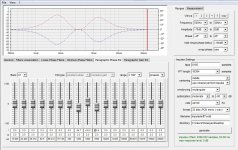 2bumpshuffle.jpg166.3 KB · Views: 251
2bumpshuffle.jpg166.3 KB · Views: 251 -
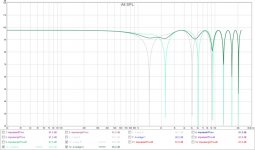 samesidebumps.jpg79.5 KB · Views: 259
samesidebumps.jpg79.5 KB · Views: 259 -
 2bumpshuflers.jpg76.3 KB · Views: 260
2bumpshuflers.jpg76.3 KB · Views: 260 -
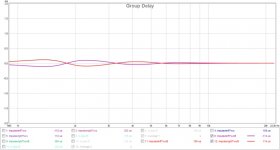 GDshuffletwoB.jpg53.8 KB · Views: 254
GDshuffletwoB.jpg53.8 KB · Views: 254 -
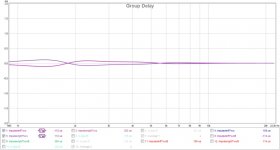 GDshuffletwoA.jpg54 KB · Views: 257
GDshuffletwoA.jpg54 KB · Views: 257 -
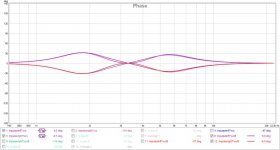 phasetwoshufflers.jpg66.5 KB · Views: 263
phasetwoshufflers.jpg66.5 KB · Views: 263
Still learning and still thinking here, but I've compared 2 off-axis plots, one without shuffle and one with to see if moving off axis was causing more trouble than the shuffler fixes.
I've moved my virtual head position (based on my own setup distances of which I have made a drawing to help figure this stuff out) 30 cm to one side.
The plots look like this:

Small change between them in favor of the non shuffled result, nothing big though.
Let's move the head the other way:

This time the superiority of the non shuffled result is gone. Still no large deviations to indicate this shuffler would be particularly bad off axis. It might favor one side over the other as one side is leading by a very small amount and the other side is trailing.
I've also looked at frequency dependent windowed plots indicating that it will not help much to shuffle the higher frequencies. Something we thought might be the case earlier on in this thread.
As this shuffler is only shifting dips over a small area I don't see any indication it would be devastating to the perception of the stereo image at any point. Different? Yes, especially in the sweet spot. but the more I think about it the more I'm sure it isn't even capable of creating any new peaks or dips by itself.
It could possibly enhance something that was off to begin with.
In other words I haven't found any real problem yet that indicates it would make things worse or that it would be a bad thing to do.
It most probably won't create new content that shouldn't be there. It could however highlight over compensation in a mix that tried to brighten the center with EQ for instance.
Any thoughts?
I've moved my virtual head position (based on my own setup distances of which I have made a drawing to help figure this stuff out) 30 cm to one side.
The plots look like this:
Small change between them in favor of the non shuffled result, nothing big though.
Let's move the head the other way:
This time the superiority of the non shuffled result is gone. Still no large deviations to indicate this shuffler would be particularly bad off axis. It might favor one side over the other as one side is leading by a very small amount and the other side is trailing.
I've also looked at frequency dependent windowed plots indicating that it will not help much to shuffle the higher frequencies. Something we thought might be the case earlier on in this thread.
As this shuffler is only shifting dips over a small area I don't see any indication it would be devastating to the perception of the stereo image at any point. Different? Yes, especially in the sweet spot. but the more I think about it the more I'm sure it isn't even capable of creating any new peaks or dips by itself.
It could possibly enhance something that was off to begin with.
In other words I haven't found any real problem yet that indicates it would make things worse or that it would be a bad thing to do.
It most probably won't create new content that shouldn't be there. It could however highlight over compensation in a mix that tried to brighten the center with EQ for instance.
Any thoughts?
Attachments
Last edited:
Hmm, the negative effects I'm experiencing right now are not related to frequency response. More about this asymmetrical feeling that the stereo image is skewed or twisted at certain frequencies. It has started physically feeling wrong. This is with my own recent (comprehensive) shufflers and Pano's rephase-2. I haven't tried any of my earlier minimal attempts (1 or 2 shifts only).
One possible cause: I started noticing these weird effects much more after doing some auto-eq with ARC2. Heavy IIR eq. It otherwise improved the center image quite a lot (and the overall stereo image - much clearer wrap around on the near field speakers). Since the ARC eq is IIR, it may already be "shuffling" in the midrange. I need to do measurements of the speakers before and after ARC, and also will try Dirac today to get a linear phase correction for comparison.
It's entirely possible that this change in my setup has made me more sensitive to the shufflers' phase shifts but I did notice them before as well - the balance of pros and cons have just "shifted".
As for the locked in head position, you are absolutely right that the higher in frequency you "correct", these phase shifts the smaller the sweet spot gets. When I was auditioning the various shuffler IRs I was extremely locked in, and so the improvements from the higher frequency shifts were noticeable (as a smoother frequency response for the center, and a tighter center image) but in typical listening I do move around a bit.
I still am unsure whether the "tight center" is a plus in terms of smooth wrap around, but I will have to look into it. Your speaker/room setup is much more tightly calibrated / anechoic so I do trust your impressions. Just reporting my own experiences. By far the worst effects were had with the Infinity speakers (wide dispersion, pulled out from walls) so its clear to me that the shuffler is both unnecessary and detrimental in a reflective environment. It may be possible / preferable to correct the center frequency response with MS eq in this setting, provided that doesn't pull apart the image either.
At this point, I am more interested in having a stereo image that is smoothly integrated from fully not-center (beyond speakers, sides of head) to fully center continously and without any areas specifically better defined than others. I realize that this is actually one of the goals of the shuffler, and I got the impression that it was working before... hmm. Just having the opposite effect right now. Very fatiguing / disturbing.
I will return to my line array thread for troubleshooting that system.
One possible cause: I started noticing these weird effects much more after doing some auto-eq with ARC2. Heavy IIR eq. It otherwise improved the center image quite a lot (and the overall stereo image - much clearer wrap around on the near field speakers). Since the ARC eq is IIR, it may already be "shuffling" in the midrange. I need to do measurements of the speakers before and after ARC, and also will try Dirac today to get a linear phase correction for comparison.
It's entirely possible that this change in my setup has made me more sensitive to the shufflers' phase shifts but I did notice them before as well - the balance of pros and cons have just "shifted".
As for the locked in head position, you are absolutely right that the higher in frequency you "correct", these phase shifts the smaller the sweet spot gets. When I was auditioning the various shuffler IRs I was extremely locked in, and so the improvements from the higher frequency shifts were noticeable (as a smoother frequency response for the center, and a tighter center image) but in typical listening I do move around a bit.
I still am unsure whether the "tight center" is a plus in terms of smooth wrap around, but I will have to look into it. Your speaker/room setup is much more tightly calibrated / anechoic so I do trust your impressions. Just reporting my own experiences. By far the worst effects were had with the Infinity speakers (wide dispersion, pulled out from walls) so its clear to me that the shuffler is both unnecessary and detrimental in a reflective environment. It may be possible / preferable to correct the center frequency response with MS eq in this setting, provided that doesn't pull apart the image either.
At this point, I am more interested in having a stereo image that is smoothly integrated from fully not-center (beyond speakers, sides of head) to fully center continously and without any areas specifically better defined than others. I realize that this is actually one of the goals of the shuffler, and I got the impression that it was working before... hmm. Just having the opposite effect right now. Very fatiguing / disturbing.
I will return to my line array thread for troubleshooting that system.
.....Any thoughts?
Not other than joking about floor bounce problem (first picture) looks some familiar in comb filter error to phantom center HRTF error, can a filter improve in this area too
Back on subject again second picture is more related here in show one wave period green and blue that sum to red trace and have phase stepped in 10º steps from 0-70º which seem be most phase apart used in shuffle filter. Sum (red) do change in amplitude and do move timing but relative low before more than 40º change.
Attachments
Last edited:
Not other than joking about floor bounce problem (first picture) looks some familiar in comb filter error to phantom center HRTF error, can a filter improve in this area too
Back on subject again second picture is more related here in show one wave period green and blue that sum to red trace and have phase stepped in 10º steps from 0-70º which seem be most phase apart used in shuffle filter. Sum (red) do change in amplitude and do move timing but relative low before more than 40º change.
I don't know what that is... floor bounce
Yes, the change between about 27 degree and 34 degree was about 1.5 dB. I've shown it as a possible solution to limit any time and phase changes. The current time difference is 114 us compared to 147 us for the original RePhase Shuffle-2. Bringing the phase angle down will soften the effects but it will still be miles ahead of that dip (relatively speaking) than the Dirac comb pulse showed. (it won't be a perceived 1.5 dB difference, way less than that)
That part will be the fine tuning if and when this experiment gets the "approved" stamp. Not there yet!
@ dynomike
It doesn't create any (electronic) or otherwise, comb filtering that i can hear. Also, amazingly adding in the mid channel doesn't seem to narrow the stereo image either !
@ wesayso
I wasn't using Any shuffle or Anything else, only the techniques i posted before, & below.
The EQ i used was Only on the mono song, as i described earlier.
********
I experimented some more today like this. But ONLY on the Mono mid track/channel.
-3db Bass, -2db Mid, -1db Hf. Incredibly, even with the mono track & stereo track both @ 0db, i was getting good stereo ! Around -6db -8db mono/mid level seemed to be about right though.
Once again i delayed the mono track by 64th of a Bar. If my calcs are correct, with the song @ 108 BPM = 8.68 ms delay ?
So i really do think there is something in my method ! I would suggest people try it, as i've suggested. Looking forward to seeing your results.
Please note, the key to achieving this appears to be using a delay, to ONLY the mixed in Mono/Mid track. NOT just mixing in a Mono/Mid track ! Experimenting more with shorter delays etc, i expect further improvements.
Of course a dedicated center speaker/s could be utilised, being fed JUST the mono delayed etc signal.
It doesn't create any (electronic) or otherwise, comb filtering that i can hear. Also, amazingly adding in the mid channel doesn't seem to narrow the stereo image either !
@ wesayso
I wasn't using Any shuffle or Anything else, only the techniques i posted before, & below.
The EQ i used was Only on the mono song, as i described earlier.
********
I experimented some more today like this. But ONLY on the Mono mid track/channel.
-3db Bass, -2db Mid, -1db Hf. Incredibly, even with the mono track & stereo track both @ 0db, i was getting good stereo ! Around -6db -8db mono/mid level seemed to be about right though.
Once again i delayed the mono track by 64th of a Bar. If my calcs are correct, with the song @ 108 BPM = 8.68 ms delay ?
So i really do think there is something in my method ! I would suggest people try it, as i've suggested. Looking forward to seeing your results.
Please note, the key to achieving this appears to be using a delay, to ONLY the mixed in Mono/Mid track. NOT just mixing in a Mono/Mid track ! Experimenting more with shorter delays etc, i expect further improvements.
Of course a dedicated center speaker/s could be utilised, being fed JUST the mono delayed etc signal.
What I meant is that due to cross talk and comb filtering, any added signal will have the same faults that we got already in this stereo concept. So it's not really fixing anything, you've just discovered reflections (Your simulating a perfect one in this case) can add to the perception. It can be a pretty neat effect though. Once you inverse that signal an put it at about -15 dB down with a delay of only 0.27 ms you'll notice some interesting sound too! It will mess with the stage. But it might clear up the center!
But if the original phantom center has cross talk problems, a later mixed in mid channel will inherit the same problems. Due to being within the Haas limits your brain won't pick it up as a separate signal. Which does not mean it doesn't create problems of it's own, probably at frequencies below 100 Hz due to interference.
It can add to our perception if you add later arriving sound. Direction of the later sound, level, frequency band passed and actual content matters though. What you're doing here will add an effect, no doubt, but not one I'd want to force onto every song. You're creating some kind of room sound, but a strange one at that. No problem if you enjoy it though!
Having fun is part of this game .
.
But if the original phantom center has cross talk problems, a later mixed in mid channel will inherit the same problems. Due to being within the Haas limits your brain won't pick it up as a separate signal. Which does not mean it doesn't create problems of it's own, probably at frequencies below 100 Hz due to interference.
It can add to our perception if you add later arriving sound. Direction of the later sound, level, frequency band passed and actual content matters though. What you're doing here will add an effect, no doubt, but not one I'd want to force onto every song. You're creating some kind of room sound, but a strange one at that. No problem if you enjoy it though!
Having fun is part of this game
Sorry to be disparaging, Zero D. I appreciate trying new things, but this doesn't solve any of the problems with the phantom center, while certainly creating more. If I may ask, what does the blending in of a delayed mono mix aim to accomplish?
Ah yes, I see why the image would not seem to narrow in your case, since you hear the sound from the left and right speakers first and locate them there (precedence or Haas effect).
Not a reflection since it comes from the exact same point in space... quite simply a mono delay. A 8ms delay is still short enough that it will cause comb filtering, in this case a complete null at ~70Hz (speed of sound in m/ms * 8ms = 2.44m = half wavelength of 70Hz) and related peaks and nulls at multiples thereof.
There is a big difference perceptually between simple electronic delays (which emerge from the same speaker as the original sound) and reflections. That's the main reason the original delay-based shuffler sounded so horrible. Flawed premise.
Ah yes, I see why the image would not seem to narrow in your case, since you hear the sound from the left and right speakers first and locate them there (precedence or Haas effect).
What I meant is that due to cross talk and comb filtering, any added signal will have the same faults that we got already in this stereo concept. So it's not really fixing anything, you've just discovered reflections (Your simulating a perfect one in this case) can add to the perception..
Not a reflection since it comes from the exact same point in space... quite simply a mono delay. A 8ms delay is still short enough that it will cause comb filtering, in this case a complete null at ~70Hz (speed of sound in m/ms * 8ms = 2.44m = half wavelength of 70Hz) and related peaks and nulls at multiples thereof.
There is a big difference perceptually between simple electronic delays (which emerge from the same speaker as the original sound) and reflections. That's the main reason the original delay-based shuffler sounded so horrible. Flawed premise.
Mike you have reminded me that I found the shuffler fatiguing in the end, too. At least the original one. I don't remember if it was cured by adjusting the overall tonal balance or not. Certainly an EQ bump in the center circa 1800-200 Hz is going to influence things. That alone can add to fatigue.
Need to get more time with it to tell if it's the shuffler, the tonal balance or both.
Need to get more time with it to tell if it's the shuffler, the tonal balance or both.
Perhaps if you took an L+R signal, which cancels signals that approach and are L-R, add strategic delays that cause a fill in of room cancellations, and then mix that back into the original L & R signals, maybe that would make the center phantom image more clear, without damaging the in between images too much. But I'd also BW limit this add-in to below 1kHZ, maybe lower.
A typical listening room seems to have enough reflections that the upper frequencies (above 500HZ) get largely evened out by the time the sound has gotten to the listener. As can be seen in the comb filter plots or actual measurements of a flat speaker in a real world room, it's the lower midrange that gets screwed the most by room reflections. Plus the lower mids have inter-aural crosstalk damaging imaging below about 1kHZ. If all you do is improve the fill-in of cancellations in the lower midrange, for the center image, maybe it would sound more whole, and thereby stand out more. The optimal delays would be somewhat different for each room.
It seems that anything you do, does damage somehow. As usual it's about tradeoffs.
In the thing I'm building, I've got a center speaker, since I now include a 42 inch video screen in the middle. I'm actually depending on the crosstalk in the stereo L-XR matrix and L+R signal to create additional delayed signals spatially, so the room reflections won't do as much damage to the overall sound. The delays will be created spatially, meaning they will be a product of different room reflections from the differently located speakers. I'm also putting electronic inter-aural cancellation on the L & R signals (using 125uS delays), but not on the L+R signal. When I sit in the middle I expect a pretty wide and nice stereo effect. Off axis, I expect a noticeably stronger center image, but diminished stereo effect. That may be as good as it gets. 'Coarse I could be wrong.
After watching the Clapton Crossroads DVD's on my system, I'm surprised that anybody doesn't want an HD TV in the middle and a center speaker to go with it. DVD's of concerts are arguably the future. To me, so much more fun than just audio.
A typical listening room seems to have enough reflections that the upper frequencies (above 500HZ) get largely evened out by the time the sound has gotten to the listener. As can be seen in the comb filter plots or actual measurements of a flat speaker in a real world room, it's the lower midrange that gets screwed the most by room reflections. Plus the lower mids have inter-aural crosstalk damaging imaging below about 1kHZ. If all you do is improve the fill-in of cancellations in the lower midrange, for the center image, maybe it would sound more whole, and thereby stand out more. The optimal delays would be somewhat different for each room.
It seems that anything you do, does damage somehow. As usual it's about tradeoffs.
In the thing I'm building, I've got a center speaker, since I now include a 42 inch video screen in the middle. I'm actually depending on the crosstalk in the stereo L-XR matrix and L+R signal to create additional delayed signals spatially, so the room reflections won't do as much damage to the overall sound. The delays will be created spatially, meaning they will be a product of different room reflections from the differently located speakers. I'm also putting electronic inter-aural cancellation on the L & R signals (using 125uS delays), but not on the L+R signal. When I sit in the middle I expect a pretty wide and nice stereo effect. Off axis, I expect a noticeably stronger center image, but diminished stereo effect. That may be as good as it gets. 'Coarse I could be wrong.
After watching the Clapton Crossroads DVD's on my system, I'm surprised that anybody doesn't want an HD TV in the middle and a center speaker to go with it. DVD's of concerts are arguably the future. To me, so much more fun than just audio.
@ wesayso
I tried the exact same settings, but inverted the mono track. I was surprised to not hear cancellations ! However the sound was somewhat harsh/distorted. The non inverted version is in a different class
Not @ all ! The more input the better
Hopefully fix a dead center image, & as you surmised, the L + R appear in their positions after a small delay.
Thanx for the Null info. As i mentioned before, even shorter delays would probably be more suitable. Even so up to now, i don't hear Anything negative.
@ Pano
Keep on shuffling
@ Bob Richards
Looking forward to reading about your experiments
*****
I have to say to anybody who's curious about this mid delay etc technique, is to try it for yourselves. Remember to play with different delay times & eq & mid level. I'd be Really interested to hear your results, & to compare with my positive ones so far.
I tried the exact same settings, but inverted the mono track. I was surprised to not hear cancellations ! However the sound was somewhat harsh/distorted. The non inverted version is in a different class
Originally Posted by dynomike
Sorry to be disparaging,
Not @ all ! The more input the better
If I may ask, what does the blending in of a delayed mono mix aim to accomplish?
Hopefully fix a dead center image, & as you surmised, the L + R appear in their positions after a small delay.
Thanx for the Null info. As i mentioned before, even shorter delays would probably be more suitable. Even so up to now, i don't hear Anything negative.
@ Pano
Keep on shuffling
@ Bob Richards
Looking forward to reading about your experiments
*****
I have to say to anybody who's curious about this mid delay etc technique, is to try it for yourselves. Remember to play with different delay times & eq & mid level. I'd be Really interested to hear your results, & to compare with my positive ones so far.
@ wesayso
I tried the exact same settings, but inverted the mono track. I was surprised to not hear cancellations ! However the sound was somewhat harsh/distorted. The non inverted version is in a different class
The same setting you had before or the ones I suggested... With his effect it is critical to get the timing right for it to be effective.
What you're doing should fatten up the sound of the phantom center. Much like what this clip explains on a vocal only track: Delay in mixing
Now they used longer delay settings in this clip, and slightly different ones left and right, but in a way this is what you are mimicking. Only without access to the separate parts, you're fattening up the entire center. But basically you're remixing
 .
.A while ago when I did not have damping on the wall behind my listening positions I had strong reflections just over 6ms behind the mains. The effect that gave was quite pleasant. Naturally I couldn't control the content of those reflections so it worked on some tracks better than others. Big busy mixes took over the room with a lot of excitement. Removing those strong reflections with a damping panel made a huge difference. But it also took away a lot of that excitement. A feeling of envelopment.
My plan had always been to try ambient channels, to mimic a bigger room and introducing later reflections (now at ~20 ms) gave back a sense of that envelopment, not nearly as strong but way more enhancing for the front stage.
You never really hear the ambient speakers do their thing, but they enhance what you hear from the mains. It really makes you feel like you're in a larger space. Yet it's subtle enough not to subtract from the original recording.
In a way I'm creating a better behaved listening room. The one I don't have available because I'm actually in a relatively small room.
This ambient trick does more for the stage than the shuffler i.m.h.o. The shuffler is really only needed when your early reflections are suppressed (or avoided) enough. Sitting in the sweet spot you'll notice the difference in tonality of the phantom center if and when you compare it to side panned vocals. Though this isn't a huge problem, it's actually very subtle. At least in my book.
@ wesayso
Thanx for all your comments & input etc Yes the inverted mono was with the same settings.
Yes the inverted mono was with the same settings.
I've been able to delay the mono track offline by even smaller amounts, & then import it/them into the multitrack software along with the stereo track. So far i've tried 4/3/2/1/0.5/0.25/0.125 ms. As i envisaged earlier, smaller delays are better. And the sub ms delays even more so.
As you say, maybe it's just having fun etc, but it's not a negative experience !
Thanx for all your comments & input etc
I've been able to delay the mono track offline by even smaller amounts, & then import it/them into the multitrack software along with the stereo track. So far i've tried 4/3/2/1/0.5/0.25/0.125 ms. As i envisaged earlier, smaller delays are better. And the sub ms delays even more so.
As you say, maybe it's just having fun etc, but it's not a negative experience !
@ wesayso
Thanx for all your comments & input etcYes the inverted mono was with the same settings.
I've been able to delay the mono track offline by even smaller amounts, & then import it/them into the multitrack software along with the stereo track. So far i've tried 4/3/2/1/0.5/0.25/0.125 ms. As i envisaged earlier, smaller delays are better. And the sub ms delays even more so.
As you say, maybe it's just having fun etc, but it's not a negative experience !
OK I'll bite. I tried this and it turned out about like I expected. I followed your directions exactly by the way - EQ, delay, mid channel only, -6dB blend. Both 0.5ms and 8.5ms. Same polarity.
Both narrowed the image putting more weight in the center (since its adding mid channel, this is what I expected). The 8.5ms delay dramatically thinned out the bass (due to the comb filter) and created a very obvious and nasty "chorus" effect (due to the delay itself). The 0.5ms delay was less noticeable although it still added center weight, perceptually darkening the center since the comb filtering started higher up. Not as much "chorus" effect but still a blurred / smeared treble.
This latter effect of the 0.5ms delay actually made me think about my corner line arrays and why the treble sounds "off". It could be the reflection under 1ms from the corners. Absorbtion right at the corners may solve this. (Will follow up on this discussion in my line array thread)
I have attached some graphs of what the two delays are doing to the frequency and phase response. And here are some samples processed with the delays:
https://www.dropbox.com/s/n9663g3db53ssld/half ms delay demo.wav?dl=1
https://www.dropbox.com/s/ogcf6u2j6ywctd3/8-9ms delay demo.wav?dl=1
Original unprocessed tracks are in this folder with the other shuffler comparisons:
https://www.dropbox.com/sh/p2eww8mm4kxl4rf/AABwdEsCWT19nk6e5jfl8o2La?dl=0
Attachments
Thanks for the phase charts.Looks like there is a phase shuffle going on in ZeroD's technique, too.
no thats just for one channel actually, the mid channel. no symmetrical wiggles L/R.
- Home
- Loudspeakers
- Multi-Way
- Fixing the Stereo Phantom Center
